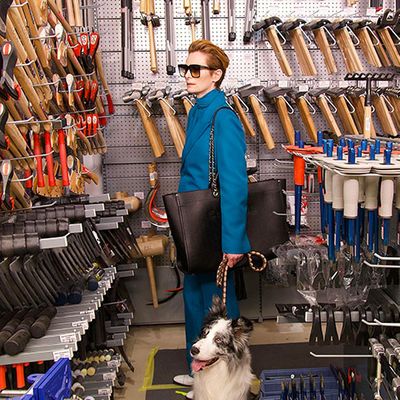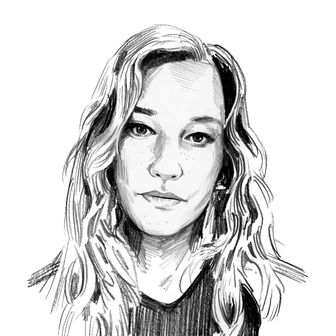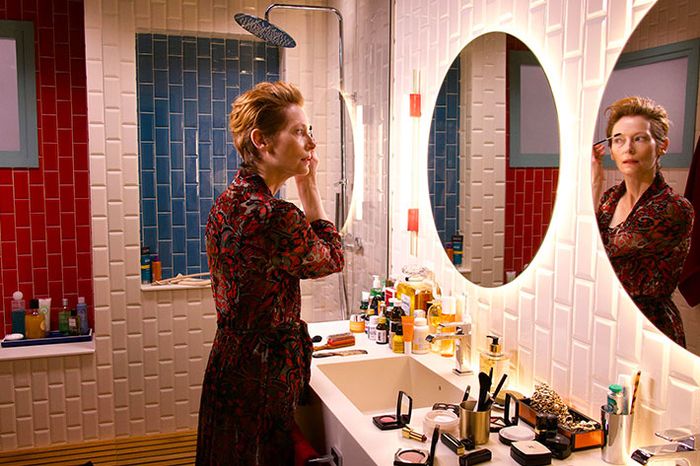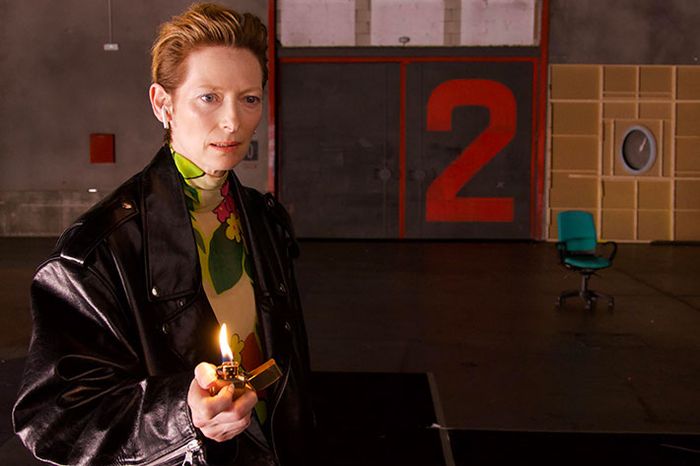
Pedro Almodóvar’s new film, a short called The Human Voice, functions as something of a jewel box for the entirety of his film career: one tiny, beguiling package encapsulating all of his beloved themes, characters, and visual motifs. References to his past work abound: Tilda Swinton plays a rebuffed woman who storms about her apartment in red couture and sticks her head under a showerhead after popping too many pills, in playful homage to Almodóvar’s protagonist Pepa Marcos (Carmen Maura) in 1988’s Women on the Verge of a Nervous Breakdown. A copy of Lucia Berlin’s short-story collection A Manual for Cleaning Women, which Almodóvar has been in the process of adapting for a few years, sits on her coffee table. An ex’s stuffed suitcase stands ominously by the door, much like the one that once plagued Pepa. The new film is also Almodóvar’s third — after 1987’s Law of Desire and Women on the Verge — to reference or be inspired by the same Jean Cocteau play, also called The Human Voice, which centers on a woman alternately pleading and acting coolly aloof over the phone with the man who’s suddenly left her.
But The Human Voice, the director’s first English-language short, also stands alone as a work of pure Almodóvarian pain, absurdity, heightened artifice, and raw emotion. Swinton is at her most Swinton-esque as the unnamed protagonist, a scorned woman who’s not just on the verge of a nervous breakdown but right the fuck inside it. She paces around her stunning, jewel-toned mid-century home in Balenciaga and Dries Van Noten (including, at one point, an amazing pair of silver lamé pants), lying to her unseen ex about going to the theater with friends while she takes an ax to his clothes. Though her existential suffering is taken seriously, Almodóvar and Swinton also play the whole thing with a sense of humor and high camp, winking at the audience; at one point, Swinton’s character, also an actress, remarks upon her industry appeal: “Women of my age are in fashion again. Apparently, people like my pallor, my mixture of madness and melancholy.” Very early on in the film, her almost-too-perfect apartment is revealed to be a set built on a dark, empty soundstage, which (spoiler alert) she eventually torches to the ground in an act of glorious revenge and catharsis.
Almodóvar and Swinton were planning to film the short right before lockdown began last year. Instead they waited until July, when things felt safer, to shoot the whole thing over several days in Madrid. A few weeks before The Human Voice’s rolling theatrical debut, which kicks off March 12, I caught up with Almodóvar, resplendent in a geometric-print sweater that wouldn’t have seemed out of place in The Human Voice. We talked about heartbreak, desperation, Tilda, filming during COVID, and the freedom of making a short film “all about me.”
Hi! I love your sweater.
Oh, thank you. It’s Prada. Miuccia is very generous with me.
Where am I reaching you, at home?
Yes, yes. I am at home, in the same place where I wrote the last eight movies that I did.
What about this space inspires you?
It’s the most comfortable. I sit at the table and close to the window, a wonderful window, which has the frame that looks like [a film screen]. I’m Spanish; I’m accustomed to the sun. I need natural light. Here is always the best place to receive the light of the day. And the rest is just … it’d be best if you’re inspired, but the rest is just to type every day. Every day. Of course, at the beginning, I write a first draft, but once you have a first draft of the movies, it’s really the moment when you start rewriting — adapting everything to the actors, and all of that. Writing is more rewriting, at least in my case.
That’s good to know, as a writer. I loved The Human Voice. When did you start thinking about doing this adaptation?
In the ’80s, I [referenced] Jean Cocteau in Law of Desire, and after that, in Women on the Verge of a Nervous Breakdown. It was my first intention to make an adaptation of The Human Voice. A woman abandoned, crazy, desperate, with the baggage of him, just waiting for his call. That was how I started. But I needed to write one hour more, because the play is quite short, so I started playing with the character two days before the phone call would happen. It became something very different, Women on the Verge. It became a screwball comedy, and in the end, she doesn’t even have the telephone call. The only thing that remains is the baggage Carmen Maura has, full of memories. The Cocteau piece was always very present in my mind, and in the last three years, I tried to make a closer adaptation of the play.
I discovered that I wanted to make it something more contemporary, because it’s impossible for women right now to identify with the idea of a submissive woman, someone submissive to her partner. That’s the point at which I made it more contemporary: not a woman who depends on her man, but who has a kind of moral autonomy. It was a very free adaptation of the original, and I kept it in my computer, and that was the key for the short.
When did you decide to frame it the way that you did, revealing that her apartment is a set right off the bat?
I always wanted to show what was behind the set — not show the mechanics behind the soundstage or the set as much as the substance, the material it’s all made of: the panels, the structures. The first idea I had, which I think is what really motivated me to take this original text to a cinema setting, was to show this woman. She’s there, she’s alone, she’s in her own house, which is realistic and a naturalist view on the house she’d have, but the idea was all about this woman going out onto her balcony, and there she is, waiting. We’ve already seen her earlier on: She’s absolutely desperate, she changes the clothes she’s wearing all the time. And she goes out onto that balcony, and it’s terrible, isn’t it? There’s no skylight. All she can see is this dirty wall about eight meters away from her window, and that’s the image I had in my head all the time. For me, that image is the absolute categorical picture of what solitude is. The solitude this woman is living in, the absurdity of her life, and the darkness that she’s living in.
The theatrical part is her on the set, which is her house, but at the same time, I was showing people where we actually were: We were making it on a soundstage. She’s walking around the soundstage, talking, and you can see that. So it’s not so much theater turned into film, but an organic blend of the two — of theater and cinema.
We’re with Tilda’s character as she’s all alone in her apartment, slowly going insane, for the duration of the short. Did you have a sense at any point in the process about the way that would resonate with all of us now, or did it shift anything in the writing process?
When we started shooting, it was back in the summer of last year; it was a time in the pandemic where there was nothing going on. And we started to shoot it as a short film right in the middle of the pandemic, with text I’d written earlier on. But somehow it became so much more powerful because of the fact that we ended up shooting the film during the pandemic. That was really so expressive of the position that this woman is in. She’s a prisoner twice over. She’s locked down twice over. She’s confined to this set, which is her house. And at the same time, we were all locked down and confined ourselves during shooting. It was one of those coincidences that very occasionally happens. I think the original idea became richer because of that coincidence.
The Human Voice really struck me as a sort of distillation of your work — like a mini version that references everything you’ve done. I noticed a lot of things were in conversation with your past work and even your future work. I know you reused some costumes and furniture. There’s Lucia Berlin’s book. Tilda even says the words “law of desire.” Talk to me about baking in those references and why you did it that way.
The short, in this case, it was all about me. [Laughs.] That was one of the reasons to do it. I felt, I don’t know how to say — capricious? The meaning for everything is, “I love this painting, I love this color of wall, I love this furniture, so I’m putting it in.” It was not gratuitous, because I wanted, since the beginning, to do everything that I like. And I felt so free to do it, because it’s a short. A short gives you much more freedom. I [could have] made it a feature, but I didn’t want to. I wanted it to last exactly as long [as] the script serves. And put in everything that I love. The pictures on the walls, that big painting by Artemisia Gentileschi that’s dominating the room, the naked woman. And yes, some of the furniture appears in other movies. Of course I didn’t dare to do that in another feature! Because then I’m afraid somebody is going to say, “You used that in The Flower of My Secret!”
But in this case, I felt like a king: very free. Not to say I didn’t feel free making Pain and Glory — I felt completely free. But this was another kind of discipline. For me, it was a kind of experiment. I also didn’t know that the movie would be released in theaters when I wrote it. But the vision, also as an experiment, was to do it in English, because that was new for me. That was another one of the reasons to make the movie the way it is, and with Tilda Swinton. I’d always dreamed of working with her. I’ve known her since a long time ago; [we met] on many red carpets and award ceremonies. I’ve always loved her. But basically as an artist, I really adore her. So when I asked her if she’d do it, even though it was a bit peculiar, she was so enthusiastic. She made it much more possible, everything that happens in front of the camera.
When I was rehearsing with her, I was frightened about the language. My English, as you see, is not that good. But with Tilda, it was different. She says that we understood each other, and that was real, because both of us talk the language of cinema. In that language, we understood each other perfectly well. At the moment, she was reading the autobiography of Michael Powell, who is one of my greatest inspirations. Martin Scorsese knows him very well, because Thelma Schoonmaker, who edits his movies, was the last wife of Michael Powell. We talked about movies and many things in common. So that was very easy for me, to be understood and for her to understand me. Since the beginning, she had a blind faith in me. And when that happens, that makes you feel very strong. And much more secure.
Early on in The Human Voice, you have Tilda at the hardware store in couture buying an ax, which is such an incredible and memorable shot. When and why did you envision that, and all of these other incredible fashion moments?
The first idea comes from that sequence in Women on the Verge, when she was destroying the stage with an ax. I kept that image at the beginning, so she went to buy one. When I say that it was everything that I like, that it was reason enough to be in the film, it’s like that when I make decisions with Tilda — she’s so physically beautiful, she can dress in everything, any dress and outfit. I love the last collection of Balenciaga, so I tried many of Balenciaga’s clothes on her. One was the first big, red dress — it was impossible to sit down in. But I loved it so much, and I loved it so much on Tilda, that I decided to make a sequence in the beginning before the titles, just to present the character in that dress, walking, lost. I knew that the spectator wouldn’t know what is happening. But she was like an abandoned mannequin in a beautiful dress. So the reason for Tilda wearing and starting off in that red gown and the black outfit is that I just simply loved how she looked in the clothes. There wasn’t a place in the script for her to wear those clothes, so I invented this, an initial pre-title sequence and presentation as her in those Balenciaga clothes.
The title sequence is also made with all of those elements you’d find at any hardware store. They’re so dangerous, aren’t they? But they’re so plastic at the same time. I’d also put that into the script and I’d gone out and found myself a hardware store, and I just loved everything I saw in it, those tools. So I decided to use the tools in that initial title sequence.
There are lines in the script that seem like they were written specifically for Tilda, like she’s commenting directly about herself. Did you write those in afterward; were you thinking of her when writing?
No, that was written before. We were in production just a year ago in February, and we had started already, we’d rehearsed, and suddenly, the pandemic came, and the confinement. So she had to go, and I stayed in Madrid. And when we resumed everything it was July, because the situation was just safe enough to keep on working. So everything was written in advance. That comment about herself [and the pallor], I wrote it since the beginning thinking of an actress like her. I wasn’t sure that she’d be there, but I thought about a person like Tilda. This kind of commentary about herself is a mix of an old — not an old lady, but someone mature, and also my own way of being desperate. It was half-based in my ideas of that situation of being abandoned by someone, and the idea of someone like Tilda, who was going to perform it.
What do you mean specifically by your own desperation? And is that why you keep returning to this play and these ideas?
This whole idea of someone who’s been abandoned by their lover — you could say it’s the mother of all situations. [Laughs.] It’s the essence of it all. It could be a man or a woman, but for me, the idea of abandonment and the despair of someone who’s been abandoned is an idea that I find really dynamic. It really prompts that person who’s been left by their lover to behave in a way to get the person back. In this particular case, the picture I had in my mind, and I think you find the same in Cocteau’s play, is this woman who’s a bit of a diva. Someone who’s been a great actress and now is in her 50s. And all of these characteristics you find in Tilda: Somebody who was a model in her past life, and she’s finding now, lo and behold, that her look is back in vogue again. But it’s this idea of being abandoned and facing total despair, when you’re facing the abyss, that emptiness. I’m familiar with that, from my own experience. So yes, there’s a bit of my own biography and my own feelings, which are distilled in this woman.
If you’re asking me why I keep going back to despair and abandonment, it’s an idea that I find extremely productive and fruitful. But anyway, I think this is the last time that I’ll use this situation. [Laughs.] I use it in The Flower of My Secret and some other movies. I’m now in production for my new movie [Madres Paralelas], and I went back to the female universe. The three protagonists are female characters, and they will be women in trouble. I can’t see myself writing about a happy woman. A woman with her wonderful, happy family? If I did that, it would be a very ironic comedy. The women in my new movie will have big problems, but they’re not abandoned by men. The problems are others.
And what’s going on with the adaptation of Lucia Berlin?
This is not the movie I’m working on now. I have the first draft of Lucia Berlin’s short stories, and I thought about it last year, trying to make locations and find out other places in Mexico and the United States, in San Francisco and Oakland. But of course, the pandemic just cut off the possibility of traveling. So the film is almost done, it’s a first draft, very close to the real script. But with the confinement, I just wrote something that is what I’m going to do now. Something much more possible. Something in Spanish, not in English. I’m going to start shooting in three weeks. Lucia needs to wait until the situation will be easier, to travel to the U.S. and Mexico. I don’t have the feeling that many people have, that they’ve lost a complete year. Fortunately, part of my work is just to be in front of the computer, writing and correcting, alone at home. So I could work. It was very profitable, because I was very concentrated. I didn’t have appointments and didn’t see anyone. I was too busy at home! And after I’ll think about Lucia Berlin. Have you read them?
I haven’t yet.
Oh, I recommend them to you! They’re so funny. They’re so dark. The brutality of herself and her writing, it makes the stories so vibrant. I really recommend it to you.
You’ve said that you see this movie as one of the only happy endings in your repertoire. How do you see it as happy, her lighting her apartment on fire — and why make a happy ending now?
Because I felt a huge empathy with the character. The words of Cocteau, they’re very precise in the pain that she’s feeling. But this is a closed cycle, that pain. So that was the key in not making this woman so submissive, like she is in Cocteau. It was a moral necessity for me to give her a way out. Also, the character of her dog is more important in my version than in the [Roberto] Rossellini version, in which the dog only appears in one frame. I wanted to underline that they were two live beings, a dog and a woman, who were abandoned. And both of them are in the same state of mourning. I was inspired by the dog at the last minute.
After she [lights the house on fire], the firefighters have to come into the set, and the dog was nervous. The idea that she goes out with the dog, that all came to me at that moment. I sat down on the set and wrote straightaway, in one go, the very last conversation with Tilda and the dog, when she says, “You know, you better get used to this. We’re all alone, I’m your mistress now. Both of us are grieving and mourning the loss we had.” We have no idea what will happen to her once that sequence is over, but what I do is break away from the closed circle of Cocteau’s monologue. Because I’m a writer and director, I felt the compulsion to liberate her. I’m opening up possibilities for her. There’s hope for her. She’s no longer stuck on this man that’s left her. What will her life be like? We don’t know. But we can imagine that because of the character that she is, it’s going to be a lot of fun.







